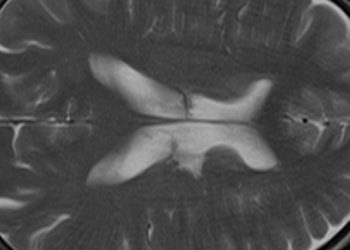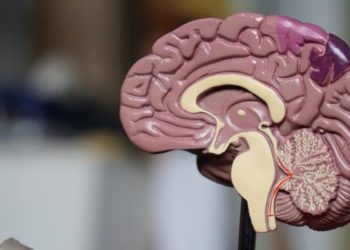Combined MRI and NIH stroke scores may predict stroke prognosis
1. A diffusion weighted imaging (DWI) parameter of >70mL of infarct volume with a NIHSS score of >20 was a highly specific predictor of poor clinical outcomes at three months following acute ischemic stroke.
2. A perfusion weighted imaging (PWI) parameter of <50 mL of mean transit time (MTT) with a NIHSS score of <8 was a highly specific predictor of good clinical outcomes at three months following acute ischemic stroke.
Evidence Rating Level: 2 (Good)
Study Rundown: In ischemic stroke patients, the penumbral area—the region of hypoperfused but salvageable brain tissue—can be represented as the volume of tissue displaying a diffusion-perfusion mismatch on magnetic resonance (MR) imaging. Such information may be used to guide decisions for reperfusion therapy outside of standard time windows or when considering non-standard intraarterial techniques, and may also be representative of collateral flow to the affected area. The current study sought to validate a previously-developed model in which a combination of clinical stroke grading, the National Institutes of Health Stroke Scale (NIHSS) score, with MR imaging parameters from both diffusion and perfusion sequences could be used to predict neurologic outcomes and stratify stroke patients for effective treatment. For patients with infarct volumes >70mL on diffusion-weighted imaging and a NIHSS score >20, a poor clinical outcome was predicted with high per-parameter specificity, while a mean transit time or maximum time of <50mL with an NIHSS score <8 predicted a good clinical outcome with high per-parameter specificity. Together, these criteria together provided an excellent positive predictive value for clinical outcomes, and a moderate prognostic yield, which was significantly increased from the use of a single parameter. These effects were augmented by stroke lateralization, as patients with non-dominant hemispheric strokes were able to tolerate larger ischemic volumes with fewer clinical complications, as demonstrated by an increased threshold for a poor outcome among right-sided strokes. Treatment type additionally affected the threshold for poor outcomes, as patients receiving intravenous or intraarterial therapy were able to tolerate larger ischemic core volumes, suggesting that treatment reduced the infarct growth rate. Among patients who did not meet the clinical and imaging thresholds delineated in this study, prognostication was inaccurate, suggesting that these patients may benefit from early invasive treatments. The study was limited by its retrospective design, a failure to determine reperfusion status by angiography in all patients, variable time to therapy and imaging in enrolled patients, and a potential for selection bias inherent to the study design in that patients receiving DWI/PWI may have had different baseline characteristics than those who did not. Future studies examining a standardized method for routine MR examination to apply these thresholds in a prospective fashion may further aid in both prognostication of stroke patients and stratification for treatment.
Click to read the study in the American Journal of Neuroradiology
In-Depth [retrospective cohort]: A total of 123 patients with acute ischemic stroke were retrospectively enrolled if they had underwent DWI and PWI within 6 hours of presentation and adequate clinical follow-up, scored by the modified Rankin Scale (mRS) at 90 days following onset. Patients were split into two groups, those with poor outcomes, and those with good outcomes, as defined by an mRS of 3-6 (n=55, 45.7%) and 0-2 (n=68, 55.3%), respectively. No significant differences in age, sex, hemispheric involvement, or time to imaging or therapy was apparent between the groups. NIHSS scores were higher among those with poor outcomes (16 vs. 7, P<0.0001) as were mean DWI, MTT, Tmax and mismatch volumes (P<0.0001) and the incidence of proximal anterior circulation occlusions versus distal (M2/M3) occlusions (P < 0.0001). Roughly half of the patients received intravenous t-PA, while 20.3% received intraarterial thrombolysis and 30.1% received no thrombolytic treatment. Application of the thresholds for a poor outcome of NIHSS >20 and DWI >70 mL versus NIHSS <8 and MTT <50 mL for a good outcome provided an overall PPV of 88.8% with a prognostic yield of 65%, greater than that for NIHSS score or DWI/PWI imaging parameters alone (P<0.01) and was able to accurately predict outcome in 71/80 patients. For those patients in whom the outcome could not be accurately predicted, the location and characteristics of their strokes did not fit the given criteria, and the patients had critical stenoses with significant comorbidities. Patients with left-sided (dominant hemispheric) strokes were unable to tolerate as large an infarct, with the infarct volume threshold decreased from 98.5mL to 51.8mL from right- to left-sided, respectively. Patients who received thrombolytic therapy of any kind were able to tolerate larger infarct volumes and still maintain good clinical outcomes versus those who did not (74.8mL vs. 20.5mL, respectively; P=0.011.)
Image: CC/Helmut Januschka
©2015 2 Minute Medicine, Inc. All rights reserved. No works may be reproduced without expressed written consent from 2 Minute Medicine, Inc. Inquire about licensing here. No article should be construed as medical advice and is not intended as such by the authors or by 2 Minute Medicine, Inc.







